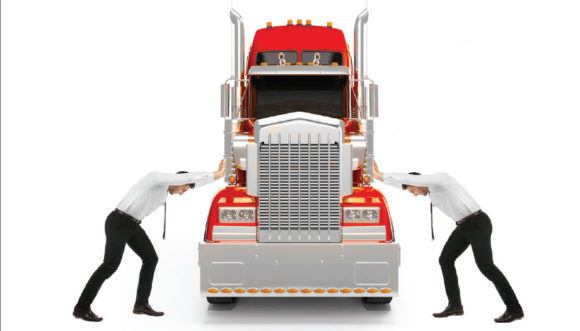Trucking serves as a barometer of the U.S. economy, representing 70.6 percent of all domestic freight transportation tonnage and $676 billion, or 79.8 percent,of transportation revenues in the country.
Despite the sector’s size, for many trucking firms, it’s a rough haul being profitable.
“Trucking companies are caught in the middle between the shipper and the consignee so they end up being squeezed on both ends,” according to Michael Birge, president, HUB International’s transportation division.’
Birge says it is an industry that is known for its thin profit margins.
Plus, it’s an industry with high costs. Labor, equipment, license and compliance, and insurance costs have all been on the rise since 2013, according to an annual survey by the American Transportation Research Institute (ATRI).
Rising insurance costs account for the biggest increase in operational costs for trucking firms. Insurance costs rose by 11 percent from 2013-2014, and rose by 29 percent from 2014-2015, according to ATRI’s “An Analysis of the Operational Costs of Trucking: 2016 Update” published September 2016.
“From freight charges going down to fuel surcharges going away to insurance costs going up, it’s very difficult for trucking firms on a micro economic level to keep making their firms successful businesses,” said Bill Wesley, president of The Campbell Group based in Caledonia, Mich.
Insurance Costs
Commercial auto continues to perform the worst among commercial lines insurance underwriting segments. The trucking industry plays a role on this insurance saga of continued unfavorable loss severity trends and growing adverse loss reserve development.
While the commercial auto market is made up of a wide-range of vehicles, trucking risks have experienced some of the most dramatic rate increases, at least in the small-to-mid-size fleet category.
“Results have not been great for insurance companies writing trucking accounts,” Birge said. Over the past two years numerous carriers – Lexington, Zurich, ProSight Specialty, Westfield – have exited trucking completely or changed their underwriting appetite for certain risks.
“Really starting about two years ago is when I think some shifts in carriers started to occur,” said Trent Tillman, executive vice president, transportation division, at TrueNorth Companies.
Tillman recalls the parade of departures.
“In the fall of 2015, Zurich was a big writer of probably a hundred motor carriers or so, trucking companies. They decided to get out of the auto liability business for truckers, altogether, as they were going through some of their overall reorganizations,” Tillman said. “Really close to the same time, AIG, Lexington in particular, who wrote a lot of the excess policies, also decided to get out. In fact, they were writing somewhere around 60 to 70 percent of the big excess in trucking. That was a huge exit of the market.”
The entire market isn’t bad; however, trucking accounts not deemed as “preferred” are feeling the pressure.
“It’s not a universal rate increase across the board but accounts that have issues where there’s loss issues or driver issues or compliance issues, they’re going to see significant rate increases,” Birge said. “Rates for the below average accounts, as perceived by the insurance companies, I’ve never seen this high in my career. It’s unbelievable.”
Segmentation
Trucking insurance brokers agree that the sector can be quite volatile but how volatile varies and depends on the segment of the market. The fact that the volatility is segmented makes the overall market for truckers more manageable and gives specialty brokers opportunities to help.
Two years ago, the large fleet trucking market was in turmoil, according to Dan Cook, national primary practice leader, transportation/large accounts, at TrueNorth Companies in Cedar Rapids, Iowa.
“When Zurich moved out of the market, they were a major player in the large fleet space. They left at the same time Lexington Insurance, the AIG division, exited the excess liability market for those large fleets.” Together those exits left a significant shortage of capacity in the large fleet space, said Cook.
Since that time the large fleet segment has rebounded somewhat but now smaller fleets — those less than 100 trucks — are experiencing the turmoil.
“There’s a lot of specialization and segmentation in the truck insurance market from company to company,” Cook said. “When you think about trucking insurance carriers, you could group them into different areas.”
Small fleets are typically 0 to 10 trucks. They are served by one group of insurance companies. Mid-market fleets are maybe 10 to 100 trucks. “There’s a lot of those size firms and they’re all privately held, serviced mostly by agents in their local market. That’s a different group of insurance companies.”
Then fleets above 250 trucks move into a different group of insurance companies, Cook said. “Part of that, what differentiates a fleet north of 100, is whether they have a low deductible or first dollar program or whether they use some form of alternative risk financing, or large deductible, self-insured retention.
“If you think about trucking in that context, you might see one group or segment experiencing rate increases but not another group, so there will be more volatility in small fleet than say large fleet,” Cook explained. That segmentation helps the overall trucking market as carriers come and go, he said.
Thirty-five-year transportation veteran Ken Cummings, assistant vice president, director of marketing for The Campbell Group’s transportation division, said that insurance pricing is competitive for the desired, established trucking companies but newer trucking firms or those with compliance or loss experience concerns are having a rough time in today’s market.
“New business ventures in the trucking industry are seeing substantially higher prices,” he said. The insurance market is so difficult for these accounts that Cummings says some truckers have even reconsidered plans to start their own trucking business after finding out the cost of the insurance.
Capacity
There is no a shortage of capacity, the experts say. What’s happened is the “traditional” truck insurers are gaining back market share, according to HUB’s Birge.
“The traditional truck insurance companies have picked up a lot of market share because there’s been not only a few that have exited, but there’s been many, many who have re-underwritten and have decided to take a tougher stand,” he said. “Some insurers are now shedding those accounts, either through huge rate increases or actually non-renewing that business which tends to flow back to the traditional truck markets.”
These brokers say the trucking market requires a broker who can direct clients through the maze of options and obstacles.
The trucking market is hardening because of poor underwriting results, which has opened the door for the alternative risk market, captives, specifically, according to Birge. “That’s a challenge to navigate so having an experienced trucking specialist is more important than ever in today’s climate,” he said.
Cummings seconds that. “It’s beneficial to work with specialists because that provides truckers with the availability to access the more competitive markets,” he said, adding that they can also help with claims.
“The truck insurance marketplace is not something for people to dabble in,” said Lance Smith, head of trucking division at PJC Insurance based in Springfield, Mo. “It’s not something that you should do, in my opinion. It requires a specialized knowledge. You need to be immersed in that every day. …
The regulatory environment, the knowledge, the specialized coverages and information that needs to be provided to insurance carriers is something that needs to be done by somebody that truly understands the business and truly understands the industry.”
Challenges
Brokers who develop an in-depth understanding of trucking issues including regional and compliance differences can excel in this sector, Birge said. “Casting a wider net and being able to focus on trucking beyond just a certain region gives you a lot of opportunities to grow, and that’s what we’ve done. It’s proven to be pretty successful.”
‘In a difficult market like this, there’s an opportunity to find other ways to differentiate ourselves.’
Specialists are helping trucking clients navigate new compliance issues.
“One of the things coming along this year is the mandate for trucking companies to have electronic logging devices required by Dec. 18 for anybody that has trucks newer than the year 2000,” Cummings said. “There are a few exceptions but the majority will have to comply with this regulation. That will have an effect on hours of service, which hopefully will bring the majority of drivers into compliance with the regulatory rules right now.”
From an underwriting perspective, requiring electronic logging devices (ELD) will make things easier. Historically, some insurers would reject accounts that did not have them. “Now they won’t have a choice,” Wesley said.
But while ELDs make securing an insurance market easier, the equipment can be costly for truckers.
Wesley says it’s imperative that his clients have ELDs on all trucks by the deadline or face penalties. “We are monitoring and asking questions when we have our visits and/or contact with our clients, just to keep them aware that the clock is ticking and it’s not going away. It will become the rule.”
Another area where specialty brokers are helping is with Compliance & Safety Accountability (CSA) scores. CSA scores are the Federal Motor Carrier Safety Administration’s data-driven safety compliance and enforcement program designed to improve safety and prevent commercial motor vehicle crashes, injuries, and fatalities. CSA consists of three core components; the Safety Measurement System; interventions; and a Safety Fitness Determination rating system to determine the safety fitness of motor carriers.
CSA evaluations and scores are widely used by underwriters. However, they may not be accurate and fair, according to HUB’s Birge.
“The methodologies have been challenged, the data has been questioned, as to its accuracy, and it’s hard to get mistakes corrected,” Birge said. “There’s been changes made to improve it and there’s been some recent legislation about the actual formula itself, whether it’s biased in one direction or another,” he said.
While there’s criticism of CSA scores, many underwriters still use them. “A lot of people rely on that score as the end-all for whether a risk is acceptable or not,” said Birge. “But people are starting to question it and we’re finally seeing some willingness to change, especially on the insurance carrier side.”
Most underwriters have moved to predictive modeling, using this data to derive rates. “There’s a substantial weighting place on these scores. It can really influence whether an account even gets a look by an underwriter, depending on their scores,” he said. If the data and score are not accurate, there can be problems.
The underwriters who are flexible and are willing to listen to an alternative story from the trucker and their broker will write more business, Birge said. “The underwriters that rely strictly on predictive modeling may not see as much business and could be subjected to adverse selection in my opinion.”
Smith agrees that CSA scores are a big factor in underwriting.
“There’s been so much increase in the data availability, data analytics that’s gone in to the industry over the last few years with carriers trying to adopt predictive modeling and trying to find the data that is actually relevant. Some data is not necessarily predictive but some of it is.”
Underwriters are trying to figure out what’s what and sometimes truckers get caught in the middle, Smith said.
“The main CSA took effect in 2010 and then there’s been changes to it over the years,” Smith said. “It depends on which side you come down, but I’ll just say there’s a lot of discussion on the methodology and how accurate it really is.”
Wesley said that in today’s challenging insurance market, agents and brokers need to find ways to stand out. Specialization will do that.
“In a difficult market like this, there’s an opportunity to find other ways to differentiate ourselves,” he said. For trucking that means becoming a true consultant. “You need to be heavy on the consulting, loss control activities, which help to improve truckers’ risk profiles, which again increases their options when they’re actually trying to find coverage options.”
Topics Carriers Agencies Auto Legislation Excess Surplus Underwriting Market Trucking
Was this article valuable?
Here are more articles you may enjoy.



 Zurich Makes £7.7 Billion Bid for Specialty Insurer Beazley
Zurich Makes £7.7 Billion Bid for Specialty Insurer Beazley  Warburg Mulls $1 Billion Sale of London Insurance Broker McGill
Warburg Mulls $1 Billion Sale of London Insurance Broker McGill  Insurance Regulators, Trades Get Behind Latest Effort to Abolish FIO
Insurance Regulators, Trades Get Behind Latest Effort to Abolish FIO  Alliant Latest to Sue Howden US Over Alleged ‘Smash-and-Grab’ Poaching
Alliant Latest to Sue Howden US Over Alleged ‘Smash-and-Grab’ Poaching 



